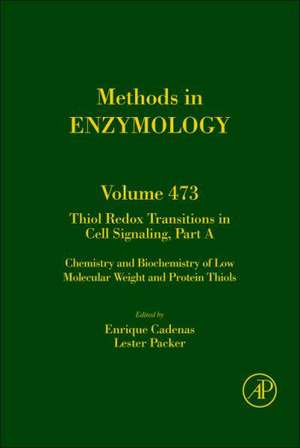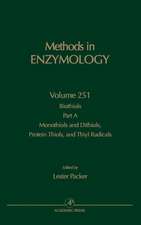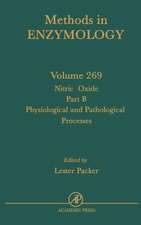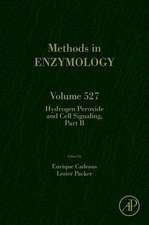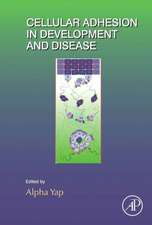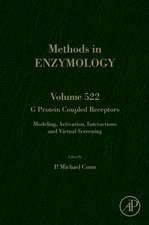Thiol Redox Transitions in Cell Signaling, Part A: Chemistry and Biochemistry of Low Molecular Weight and Protein Thiols: Methods in Enzymology, cartea 473
Enrique Cadenas, Lester Packeren Limba Engleză Hardback – 21 iul 2010
The critically acclaimed laboratory standard for 40 years, Methods in Enzymology is one of the most highly respected publications in the field of biochemistry. Since 1955, each volume has been eagerly awaited, frequently consulted, and praised by researchers and reviewers alike. Over 450 volumes have been published to date, and much of the material is relevant even today--truly an essential publication for researchers in all fields of life sciences.
- Along with companion volume, provides a full overview of techniques necessary to the study of thiol redox in relation to cell signaling
- Gathers tried and tested techniques from global labs, offering both new and tried-and-true methods
- Relevant background and reference information given for procedures can be used as a guide to developing protocols in a number of disciplines
Din seria Methods in Enzymology
-
 Preț: 390.54 lei
Preț: 390.54 lei -
 Preț: 391.30 lei
Preț: 391.30 lei -
 Preț: 392.01 lei
Preț: 392.01 lei -
 Preț: 391.01 lei
Preț: 391.01 lei - 28%
 Preț: 801.23 lei
Preț: 801.23 lei - 32%
 Preț: 802.54 lei
Preț: 802.54 lei - 23%
 Preț: 461.36 lei
Preț: 461.36 lei - 23%
 Preț: 460.60 lei
Preț: 460.60 lei - 23%
 Preț: 439.86 lei
Preț: 439.86 lei - 23%
 Preț: 448.15 lei
Preț: 448.15 lei - 23%
 Preț: 451.42 lei
Preț: 451.42 lei - 23%
 Preț: 445.18 lei
Preț: 445.18 lei - 5%
 Preț: 557.15 lei
Preț: 557.15 lei - 23%
 Preț: 450.67 lei
Preț: 450.67 lei - 23%
 Preț: 446.23 lei
Preț: 446.23 lei - 23%
 Preț: 435.87 lei
Preț: 435.87 lei - 23%
 Preț: 445.94 lei
Preț: 445.94 lei - 23%
 Preț: 459.55 lei
Preț: 459.55 lei - 23%
 Preț: 460.02 lei
Preț: 460.02 lei - 23%
 Preț: 450.54 lei
Preț: 450.54 lei - 23%
 Preț: 453.47 lei
Preț: 453.47 lei - 5%
 Preț: 565.37 lei
Preț: 565.37 lei - 23%
 Preț: 450.67 lei
Preț: 450.67 lei - 23%
 Preț: 464.33 lei
Preț: 464.33 lei - 23%
 Preț: 441.49 lei
Preț: 441.49 lei - 23%
 Preț: 447.44 lei
Preț: 447.44 lei - 23%
 Preț: 459.13 lei
Preț: 459.13 lei - 23%
 Preț: 450.38 lei
Preț: 450.38 lei - 23%
 Preț: 445.80 lei
Preț: 445.80 lei - 23%
 Preț: 445.35 lei
Preț: 445.35 lei - 23%
 Preț: 442.53 lei
Preț: 442.53 lei - 23%
 Preț: 450.38 lei
Preț: 450.38 lei - 23%
 Preț: 448.60 lei
Preț: 448.60 lei - 23%
 Preț: 447.57 lei
Preț: 447.57 lei - 23%
 Preț: 440.90 lei
Preț: 440.90 lei - 23%
 Preț: 448.15 lei
Preț: 448.15 lei - 23%
 Preț: 466.84 lei
Preț: 466.84 lei - 23%
 Preț: 451.42 lei
Preț: 451.42 lei - 23%
 Preț: 453.64 lei
Preț: 453.64 lei - 23%
 Preț: 459.13 lei
Preț: 459.13 lei - 23%
 Preț: 457.49 lei
Preț: 457.49 lei - 23%
 Preț: 447.44 lei
Preț: 447.44 lei - 5%
 Preț: 561.34 lei
Preț: 561.34 lei - 23%
 Preț: 447.57 lei
Preț: 447.57 lei - 23%
 Preț: 453.35 lei
Preț: 453.35 lei - 23%
 Preț: 441.95 lei
Preț: 441.95 lei - 23%
 Preț: 450.38 lei
Preț: 450.38 lei - 23%
 Preț: 449.19 lei
Preț: 449.19 lei - 23%
 Preț: 456.02 lei
Preț: 456.02 lei
Preț: 847.82 lei
Preț vechi: 1243.03 lei
-32% Nou
Puncte Express: 1272
Preț estimativ în valută:
162.25€ • 176.18$ • 136.29£
162.25€ • 176.18$ • 136.29£
Carte tipărită la comandă
Livrare economică 15-29 aprilie
Preluare comenzi: 021 569.72.76
Specificații
ISBN-13: 9780123813459
ISBN-10: 012381345X
Pagini: 416
Dimensiuni: 152 x 229 x 25 mm
Greutate: 0.8 kg
Editura: ELSEVIER SCIENCE
Seria Methods in Enzymology
ISBN-10: 012381345X
Pagini: 416
Dimensiuni: 152 x 229 x 25 mm
Greutate: 0.8 kg
Editura: ELSEVIER SCIENCE
Seria Methods in Enzymology
Public țintă
Researchers and students in biochemistry, cardiology, cell and molecular biology, neuroscience, pharmacology, endocrinology.Cuprins
- His-tag switch method for the analysis of S-nitrosylated proteins
- Identification of Protein Thiols in Mitochondrial Oxidative Phosphorylation Complexes
- Mitochondrial thioredoxin reductase: purification, inhibitor studies, and role in cell signaling
- assessing cell surface thiol status
- Induction of Thioredoxin for Mediating Preconditioning-induced Cellular Responses
- A trans sarcoplasmic reticulum membrane redox sensor in the striated muscle: exploring redox sensitivity of the ryanodine receptor calcium release channel
- Rapid approach for the detection, quantification and discovery of novel sulphenic acid or S-nitrosothiol modified proteins using a biotin-switch method
- Direct identification by mass spectrometry of in vivo S-nitrosylated peptides
- Changing paradigms in theology: From antioxidant defence to redox regulation
- Determination of GSNO formation in biological samples by HPLC electrochemical detection
- Alteration of thioredoxin reductase 1 levels in elucidating cancer etiology
- thiol-labeling technology in proteomics
- Analytical methods for the determination of sulfur metabolite concentrations in cell extracts
- Chemical tagging and mass spectrometry-based identification of protein thiols modified by lipid peroxidation-derived a,b-unsaturated aldehydes
- Measuring protein thiol redox changes in mitochondria
- Engineering of redox domains for monitoring electron transfers spectroscopically
- Approaches to detection of cysteine sulfenic acids in proteins using dimedone-based chemical probes
- Evaluation of conditions affecting degree of sulfenic acid labeling in redox-sensitive proteins
- Colorimetric and spectrophotometric assays of sulfiredoxin
- Quantifying disulfides in specific proteins
- A simple method of detecting oxidatively-modified proteins
- Role of Glutathione Conjugates in Cell Signaling
- Regulation of Protein Function by Sulfinic Acid Formation
- Mass spectrometry approaches for the study of the oxidation state of protein cysteine residues
- assays of protein tyrosine phosphatase oxidation
- oxidation state of cellular 2-Cys peroxiredoxins (reduced thiol, disulfide and hyperoxidised) by non-reducing SDS-PAGE and immunoblotting
